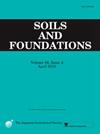Experimental study on thermal conductivity and microscopic characterization of sandy clay in deep buried formation
IF 3.3
2区 工程技术
Q2 ENGINEERING, GEOLOGICAL
引用次数: 0
Abstract
The thermal conductivity of soil is a key factor influencing the heat transfer process and temperature distribution, which has significant implications for the design and implementation of freezing methods in geotechnical engineering. To address the challenge of freezing the deeply buried sandy clay layer using the freezing method in the drilling wells of the Huainan-Huaibei mining area, experimental research was conducted on the thermal conductivity of sandy clay and its microstructure. Utilizing the transient plane source method, variations in thermal conductivity with water content, dry density, sand content, and temperature were observed, revealing the patterns and mechanisms underlying these changes. The findings indicate that the thermal conductivity of frozen sandy clay mainly undergoes three stages of temperature variation. During the rapid increase phase (Ⅱ), the thermal conductivity rises sharply with decreasing temperature, exhibiting a “leap” trend. As the water content increases, the range of the thermal conductivity leap gradually narrows. When the water content increases from 15 % to 22.5 %, the corresponding leap range decreases to 0 ∼ -5℃. Microstructural parameters quantitatively reflect the intrinsic reasons for changes in soil thermal conductivity from a microscopic perspective, indicating that these characteristics significantly affect its thermal conductivity.
深埋地层砂质粘土热导率及微观表征实验研究
土体导热系数是影响土体传热过程和温度分布的关键因素,对岩土工程中冻结方法的设计和实施具有重要意义。针对淮南-淮北矿区深埋砂质粘土层采用冻结法冻结的难题,对砂质粘土的导热系数及其微观结构进行了试验研究。利用瞬态平面源方法,观察了热导率随含水量、干密度、含砂量和温度的变化,揭示了这些变化的模式和机制。研究结果表明,冻结砂质粘土的导热系数主要经历三个阶段的温度变化。在快速增加阶段(Ⅱ),随着温度的降低,导热系数急剧上升,呈现“飞跃”趋势。随着含水率的增加,导热系数跃变的范围逐渐缩小。当含水量从15%增加到22.5%时,相应的跃变范围减小到0 ~ -5℃。微观结构参数从微观角度定量反映了土壤导热系数变化的内在原因,表明这些特征对土壤导热系数有显著影响。
本文章由计算机程序翻译,如有差异,请以英文原文为准。
求助全文
约1分钟内获得全文
求助全文
来源期刊

Soils and Foundations
工程技术-地球科学综合
CiteScore
6.40
自引率
8.10%
发文量
99
审稿时长
5 months
期刊介绍:
Soils and Foundations is one of the leading journals in the field of soil mechanics and geotechnical engineering. It is the official journal of the Japanese Geotechnical Society (JGS)., The journal publishes a variety of original research paper, technical reports, technical notes, as well as the state-of-the-art reports upon invitation by the Editor, in the fields of soil and rock mechanics, geotechnical engineering, and environmental geotechnics. Since the publication of Volume 1, No.1 issue in June 1960, Soils and Foundations will celebrate the 60th anniversary in the year of 2020.
Soils and Foundations welcomes theoretical as well as practical work associated with the aforementioned field(s). Case studies that describe the original and interdisciplinary work applicable to geotechnical engineering are particularly encouraged. Discussions to each of the published articles are also welcomed in order to provide an avenue in which opinions of peers may be fed back or exchanged. In providing latest expertise on a specific topic, one issue out of six per year on average was allocated to include selected papers from the International Symposia which were held in Japan as well as overseas.
 求助内容:
求助内容: 应助结果提醒方式:
应助结果提醒方式:


